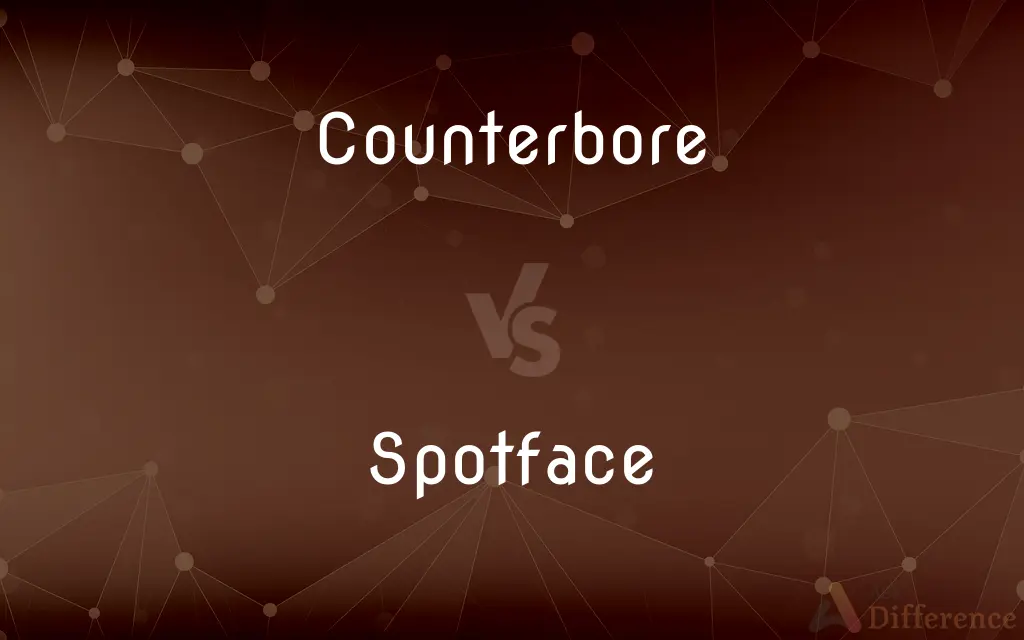Counterbore vs. Spotface — What's the Difference?
By Maham Liaqat & Fiza Rafique — Updated on February 22, 2024
A counterbore creates a flat-bottomed enlargement at the top of a hole for a bolt head or nut, while a spotface smooths out a surface area around a hole to ensure a flat seating for a fastener head.

Difference Between Counterbore and Spotface
Table of Contents
ADVERTISEMENT
Key Differences
Counterboring is a machining process that enlarges a hole's top section to a specific diameter, allowing for the accommodation of bolt heads or nuts, ensuring they sit flush with or below the surface of the material. This is particularly useful in applications where the structural integrity and aesthetic of the assembly are crucial. Spotfacing, on the other hand, is focused on creating a flat surface around an existing hole. This is often necessary when the surface is irregular or rough, ensuring that a fastener can be properly seated and secured.
Both processes are used to prepare holes for fasteners, while the key difference lies in their scope and application. Counterboring is concerned with modifying the hole itself, making it wider and creating space for hardware. Spotfacing, however, does not alter the hole's diameter but instead cleans up the area around it to provide a stable, flat mounting surface.
The tools used for these processes also differ. Counterbores are typically larger and have a pilot bit to guide the tool into the existing hole, ensuring alignment and accuracy. Spotface tools, or spotfacers, are smaller and designed to cut a precise, shallow depth around the hole's perimeter without changing the hole's size.
In terms of application, counterboring is often seen in mechanical and structural engineering where bolts and screws must be flush with or recessed into the material's surface. Spotfacing is common in assemblies where the surface irregularities could prevent a fastener from being properly tightened, such as in castings or rough metal surfaces.
Comparison Chart
Definition
Enlarges the top part of a hole for bolt heads or nuts.
Creates a flat area around a hole for a fastener head.
ADVERTISEMENT
Purpose
To allow fasteners to sit flush with or below the surface.
To ensure a flat seating surface for fasteners.
Process
Enlarges hole diameter at the top.
Cleans and flattens the surface area around a hole.
Tool Type
Larger with a pilot bit for alignment.
Smaller, designed for shallow, precise cuts around a hole.
Application
Used in structural assemblies for aesthetic and integrity reasons.
Used where surface irregularities could compromise fastening.
Compare with Definitions
Counterbore
A machining process to enlarge the top section of a hole for fastener accommodation.
The mechanic counterbored the holes on the engine mount to fit the new bolts.
Spotface
A machining process to create a flat surface around a hole for fastener seating.
Spotfacing the gearbox ensured the bolt heads would tighten evenly.
Counterbore
Used for structural and aesthetic purposes in various assemblies.
Counterboring the beams allowed for a sleek, bolt-free appearance.
Spotface
Ensures a fastener head sits properly, even on irregular surfaces.
The spotfaced areas on the casting allowed for secure bolt installation.
Counterbore
Designed to create space for hardware to sit flush or below the material surface.
Counterboring was necessary to ensure the machine's surface remained smooth.
Spotface
Spotfacers are used to prepare surfaces for precise fastening.
The machinist spotfaced the flange to ensure a perfect seal.
Counterbore
Counterbores make room for fasteners without changing the hole's depth.
The technician counterbored the panel to install the flush-mounted screws.
Spotface
Involves cleaning and flattening around a hole without altering its diameter.
Spotfacing was required to correct the surface imperfections around the holes.
Counterbore
Involves enlarging and deepening a hole at one end.
The carpenter used a counterbore to fit the screw heads neatly into the table.
Spotface
Common in settings where surface irregularities could affect fastening.
Spotfacing the engine block ensured the bolts would hold under high stress.
Counterbore
A counterbore (symbol: ⌴) is a cylindrical flat-bottomed hole that enlarges another coaxial hole, or the tool used to create that feature. A counterbore hole is typically used when a fastener, such as a socket head cap screw, is required to sit flush with or below the level of a workpiece's surface.
Spotface
(transitive) to create or fashion a spotface
Counterbore
To form a counterbore in, by boring, turning, or drilling; to enlarge, as a hole, by means of a counterbore.
Spotface
A spotface or spot face is a machined feature in which a certain region of the workpiece (a spot) is faced, providing a smooth, flat, accurately located surface. This is especially relevant on workpieces cast or forged, where the spotface's smooth, flat, accurately located surface stands in distinction to the surrounding surface whose roughness, flatness, and location are subject to wider tolerances and thus not assured with a machining level of precision.
Counterbore
A cylindrical recess, typically machined around a hole to admit a screw so that it sits flush with a surface.
Spotface
A shallow machined face, especially a shallow circular or cylindrical recess, machined on (for example) a cast part to offer a flat face against which to seat a fastener (often a shallow counterbore).
Counterbore
A flat-bottomed cylindrical enlargement of the mouth of a hole, usually of slight depth, as for receiving a cylindrical screw head.
Common Curiosities
What is the main purpose of counterboring?
To enlarge the top part of a hole to accommodate bolt heads or nuts flush with the surface.
When would you use spotfacing?
When needing a flat, clean area around a hole to ensure even seating for a fastener.
Is spotfacing necessary on all types of surfaces?
No, it's typically used on uneven or rough surfaces where a flat seating for a fastener is needed.
Can counterboring affect a material's strength?
Yes, it can reduce material thickness around the hole, potentially weakening the structure.
How do you choose between counterboring and spotfacing?
The choice depends on whether you need to enlarge a hole or just prepare its surrounding surface.
Is counterboring only for metal materials?
No, it can be performed on various materials, including plastics and wood, depending on the application.
Does spotfacing require special equipment?
Yes, spotfacers or spotfacing cutters are used, designed for shallow, precise cuts.
What happens if a spotfaced surface is not perfectly flat?
An uneven spotfaced surface can lead to improper fastener seating, compromising the assembly's integrity.
Are there standard sizes for counterbores and spotfacers?
Yes, there are standard sizes, but custom sizes can be made for specific applications.
Is spotfacing only for bolt heads?
While commonly for bolt heads, it's also used for any fastener requiring a flat seating surface.
Can the same tool be used for both counterboring and spotfacing?
While some tools may be adaptable, specific tools are designed for each process for optimal results.
How do you ensure alignment during counterboring?
Counterbore tools often have pilot bits to guide the cutting end into the existing hole accurately.
Can spotfacing be done manually?
While possible, precision spotfacing is typically done with machine tools for accuracy.
How deep can a counterbore be?
The depth varies based on the application's requirements and the fastener used.
Can counterboring be reversed or corrected?
Not easily; it involves removing material, so corrections typically require filling or re-machining.
Share Your Discovery

Previous Comparison
Subsequently vs. Consequently
Next Comparison
Meany vs. MeanieAuthor Spotlight
Written by
Maham LiaqatCo-written by
Fiza RafiqueFiza Rafique is a skilled content writer at AskDifference.com, where she meticulously refines and enhances written pieces. Drawing from her vast editorial expertise, Fiza ensures clarity, accuracy, and precision in every article. Passionate about language, she continually seeks to elevate the quality of content for readers worldwide.















































